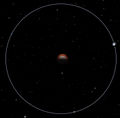Difference between revisions of "Duna/pl"
| Line 39: | Line 39: | ||
|} | |} | ||
| − | == | + | == Atmosfera == |
{| | {| | ||
| | | | ||
| − | [[File:Atmosphere_kerbin_duna.png|thumb|right| | + | [[File:Atmosphere_kerbin_duna.png|thumb|right|Porównanie atmosfery Duny i Kerbinu]] |
| − | + | Atmosfera Duny rozpoczyna się na wysokości 14,446 m. Jej gęstość stanowi tylko 20% gęstości atmosfery [[Kerbinu]] na wysokości 0 m, i staje się procentowo jeszcze rzadsza na wyższych pułapach. | |
Like the atmospheres of [[Eve]] and Kerbin, Duna's atmosphere fades exponentially with increasing altitude (with a scale height of 3000 m). In general, the atmospheric pressure on Duna at an altitude expressed in meters is:<ref>A [[LV-N Atomic Rocket Engine|nuclear engine]] has a specific impulse of 220 in 1 atm, 800 in vacuum, and the following at various Duna altitudes: | Like the atmospheres of [[Eve]] and Kerbin, Duna's atmosphere fades exponentially with increasing altitude (with a scale height of 3000 m). In general, the atmospheric pressure on Duna at an altitude expressed in meters is:<ref>A [[LV-N Atomic Rocket Engine|nuclear engine]] has a specific impulse of 220 in 1 atm, 800 in vacuum, and the following at various Duna altitudes: | ||
Revision as of 13:55, 1 November 2012
Duna Jest czwartą planetą systemu Kerbol. Jest odpowiednikiem Marsa, ma barwę czerwoną, i posiada czapy lodowe na biegunach. Posiada jednego naturalnego satelitę, księżyc Ike. Ze względu na wzajemną bliskość, Ike i Duna znajdują się w synchronicznej rotacji.
Contents
Topografia
|
Duna jest planetą bogatą w żelazo, z dużymi wahaniami w wysokości terenu, co znacznie utrudnia znalezienie dobrego miejsca do lądowania. Lądowanie utrudnia również rzadka atmosfera która nie daje możliwości znacznego hamowania atmosferycznego. Na powierzchni w kilku miejscach znajdują się tzw. "mare" (łac. morze) dające się rozpoznać dzięki ciemniejszemu zabarwieniu powierzchni na wysokości dokładnie 0 m. Są one najlepszymi terenami do lądowania dzięki niskiemu położeniu i gęstszej atmosferze pozwalającej na odrobinę hamowania atmosferycznego. Oba bieguny są bardzo duże, co jest spowodowane rzadką atmosferą. Centralne regiony układają się w kształt przypominający Europę. |
Atmosfera
|
Atmosfera Duny rozpoczyna się na wysokości 14,446 m. Jej gęstość stanowi tylko 20% gęstości atmosfery Kerbinu na wysokości 0 m, i staje się procentowo jeszcze rzadsza na wyższych pułapach. Like the atmospheres of Eve and Kerbin, Duna's atmosphere fades exponentially with increasing altitude (with a scale height of 3000 m). In general, the atmospheric pressure on Duna at an altitude expressed in meters is:[1] Parachutes work at lower efficiency than on Kerbin, making powered descent necessary when landing from orbit (unless your craft is a glider or just a pod with a parachute). |
Orbital Statistics
The geosynchronous orbit of Duna is at an altitude of 0,00 m above Duna. The speed of the satellite is 0,00 m/s and it has an orbital period resonating with 1 Duna day (18.2 hours or 65517.859375 seconds).
For a semi-synchronous orbit of ½ Duna day (9.025 hours or 32490 seconds) an orbit of 0,00 m above Duna is needed with a velocity of 0,00 m/s.
Reference Frames
| Warp | 5x, 10x | 50x | 100x | 1000x | 10,000x | 100,000x |
| Minimum Altitude | above atmosphere | 60 km | 100 km | 300 km | 600 km | 800 km |
Gallery
- Duna projection.png
A false color Mercator projection of Duna's surface using MapSat.
Changes
- Initial Release
Notes
- ↑ A nuclear engine has a specific impulse of 220 in 1 atm, 800 in vacuum, and the following at various Duna altitudes:
altitude (m) 2 100 300 500 1460 2420 3000 4272 5000 10000 specific impulse 684.1 687.8 695.1 701.8 728.7 748.2 757.3 772.1 778.1 795.9






